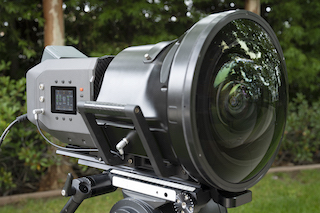 Academy Award-nominee Darren Aronofsky is currently directing the feature-length documentary film Postcard from Earth, a first-of-its-kind production set to debut at Sphere in Las Vegas this October. Aronofsky is utilizing the Big Sky camera system to capture content for the immersive production, which will fully-maximize Sphere’s 22nd century technologies – including the world’s highest resolution LED screen, the world’s most advanced concert audio system, and atmospheric elements such as wind and scent – to transport audiences to places both real and imagined.
Academy Award-nominee Darren Aronofsky is currently directing the feature-length documentary film Postcard from Earth, a first-of-its-kind production set to debut at Sphere in Las Vegas this October. Aronofsky is utilizing the Big Sky camera system to capture content for the immersive production, which will fully-maximize Sphere’s 22nd century technologies – including the world’s highest resolution LED screen, the world’s most advanced concert audio system, and atmospheric elements such as wind and scent – to transport audiences to places both real and imagined.
Earlier this month Sphere Entertainment launched Sphere Studios, dedicated to developing original immersive entertainment exclusively for Sphere, through proprietary technology, tools and production facilities. The first of the studios’ technology introductions included Big Sky – an ultra-high resolution camera system.
The studio campus in Burbank spans 68,000-square-feet of development facilities; production, editing and post-production suites; sound stages for mixing spatial audio; and camera and 3D printing labs. The campus also includes Big Dome, a 28,000-square-foot, 100-foot-high custom geodesic dome with a quarter-sized version of the screen at Sphere in Las Vegas. Big Dome serves as a specialized screening, production facility and lab for content at Sphere, including Sphere Immersive Sound, haptic seats, and more that will be featured at Sphere.
![When completed, the Sphere, announced last year, is expected to be the largest spherical structure in the world at 336 feet tall and 516 feet wide, and serve as, what one media outlet called “a radical new entertainment venue that can accommodate up to 20,000 [standing] spectators.” The venue will seat 17,500 The Sphere’s dome alone weighs 13,000 tons and has a surface area of 220,000 square feet.](/sites/default/files/users/30/2023/postcard_2.png) The Big Sky camera system and custom content creation tool, was created by Sphere Studios to capture the images and video required for the world’s highest resolution LED screen at Sphere. Developed in-house at Sphere Studios’ research and development labs, every aspect of Big Sky represents a significant advancement on current cinema camera systems, including the largest single sensor in commercial use capable of capturing incredibly detailed, large-format images.
The Big Sky camera system and custom content creation tool, was created by Sphere Studios to capture the images and video required for the world’s highest resolution LED screen at Sphere. Developed in-house at Sphere Studios’ research and development labs, every aspect of Big Sky represents a significant advancement on current cinema camera systems, including the largest single sensor in commercial use capable of capturing incredibly detailed, large-format images.
When completed, the Sphere, announced last year, is expected to be the largest spherical structure in the world at 336 feet tall and 516 feet wide, and serve as, what one media outlet called “a radical new entertainment venue that can accommodate up to 20,000 [standing] spectators.” The venue will seat 17,500 The Sphere’s dome alone weighs 13,000 tons and has a surface area of 220,000 square feet.
The dome uses six million pounds of steel. Construction costs have been estimated in various media outlets at more than $1.8 billion, and the building isn’t completed yet.
It’s expected to house a record 160,000-square-foot wraparound LED display on the interior, while the exterior will be coated with a record 580,000-square-foot of exterior LED display. The LED display can accommodate 16K-by-16K picture resolution. Through a partnership with Berlin-based audio company Holoplot, the Sphere will also house a custom spatial audio system, and additional plans include 4D capabilities from wind to scents, as well as connectivity for all guests.
 The screen covers an area larger than three football fields. The outside of the Sphere will have about 600,000 square feet of programmable lighting. The venue will use an acoustic system utilizing “beamforming” technology, with 157,000 ultra-directional speakers. The Sphere will also feature an infrasound haptic system enabling audiences to feel the sound.
The screen covers an area larger than three football fields. The outside of the Sphere will have about 600,000 square feet of programmable lighting. The venue will use an acoustic system utilizing “beamforming” technology, with 157,000 ultra-directional speakers. The Sphere will also feature an infrasound haptic system enabling audiences to feel the sound.
Aronofsky, the creator, director, and producer of Postcard from Earth, said, “I see Sphere as a great opportunity to pluck people from the bling and thrum of the Vegas strip in all its human constructed madness and immerse them as fully as possible in the wonder, awe, and beauty of the natural world. Postcard from Earth is a sci-fi journey deep into our future as our descendants reflect on our shared home.”
“At its best,” he said, “cinema is an immersive medium that transports the audience out of their regular life, whether that’s into fantasy and escapism, another place and time, or another person’s subjective experience. The Sphere is an attempt to dial up that immersion.”
“Every day we’ve taken out the camera we’ve gotten better at getting the best possible shots. It’s a learning process because the technology is new,” Aronofsky continued. “And it’s the same with post. Delivering a half-petabyte movie – that’s 500,000 gigabytes – that utilizes more than 160,000 speakers is mind boggling. But honestly, every film is always a learning experience. You are always in a process discovering the language of the film and unearthing the story using the tools you’ve got at hand. Here it’s about how to make the beauty and fragility of our planet feel as potent as possible. The tools might be a little different on this film, but the task is the same.”
Most recently, Aronofsky directed the A24 film The Whale starring Brendan Fraser, who won a Best Actor Academy Award for his performance. MacArthur winning playwright Samuel D. Hunter adapted the screenplay from his critically acclaimed play. In 2010, Aronofsky received a Best Director Academy Award nomination for the indie box office phenomenon Black Swan starring Natalie Portman, who won a Best Actress Academy Award for her performance.
Aronofsky concluded, “Postcard actually has narrative elements as well documentary ones. We designed it to be as effective as possible to communicate the message we wanted to deliver in an emotional way, so it’s less about genre than about the audience experience.”
Postcard from Earth will feature captivating scenes from every continent and take audiences on an extraordinary journey to unexpected places around our planet without ever leaving their seats in Las Vegas.
